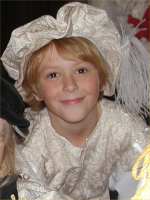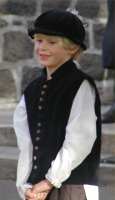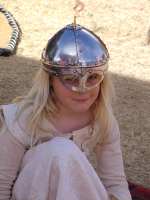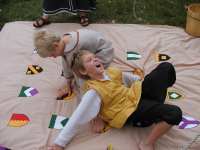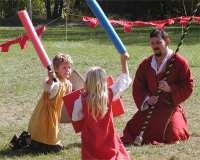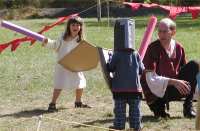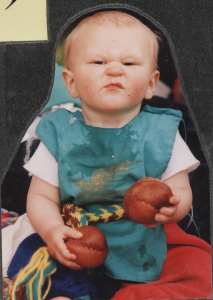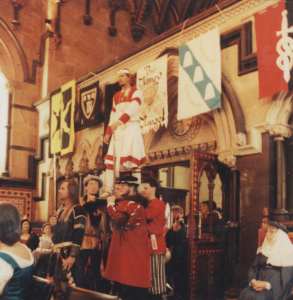 |
|
For the Children
[Demos for Children and Youth Groups] A lot of the things I have done over the years have been to keep my own children amused or educated, and to help amuse or educate others. Here is a selection of what we've done together, ranging from rhymes for the very young to the more organised activities such as page school, reflecting the changing ages of my children. They're now considerably bigger than the shots below, but I like to remember back then.
Page School itself has a separate section. If you want to see the sorts of things we've organised for Canterbury Faire and the youngsters who attend, take a look here. I've also included there Baron Callum MacLeod's delightful instructions on how to be a good page, along with Dickon's response. Game of Goose: El Juego de la OcaThis was made as my final AS50 Challenge entry into a Kingdom Arts & Sciences Competition at Twelfth Night Coronation, appropriately enough held in in my home barony of Southron Gaard. The Game of Goose is an early board game involving the rolling of dice and progressing around a set of numbered squares, meeting various obstacles and benefits along the way. It is widely recorded as having been given by Francesco de Medici of Florence to Philip II of Spain, and variations are found throughout Europe (Nelson, Ciompi). John Wolfe registered it at Stationers Hall in London as the Newe and Most Pleasant Game of the Goose on 16 June, 1597; the earliest extant English version is dated 1660. The earliest surviving European version was carved in stone in 1589; using Fortuna instead of geese. The game’s spread can be judged by the many translations of the name found in Europe and Scandinavia -- El Juego de la Oca, Jeu de l'Oie, Gioco dell'Oca, Ganse-Spiel, Ganzenspel, Gaasespil, Gasspelet. There are very many images and rules, resulting in thousands of variants – not even the goose is retained in all of them, though the spiral race and the chance to make an extra throw on reaching a beneficial square are maintained. It is still played to this day in a format which Francesco could well recognise as familiar to him. Most versions of the game are characterised by the presence of the goose in a number of squares, along with a bridge, a well, an inn, a prison, a maze or labyrinth, a death’s head and some dice; all these are associated with rules relating to moving ahead or behind or other actions. In addition, many of these actions require the payment of an agree-upon ante into a common pot, to go to the eventual winner.
According to some (eg Ciompi & Seville, Mascheroni & Tinti), the game has cabbalistic underpinnings, reflecting Renaissance fascination with Jewish mystical thought developed during the 12-13th centuries in Spain. There are seven sequences of nine (the goose representing the end spot for each sequence) echoing the seven ages of man from mewling infant to the old age of second childishness, as Shakespeare put it. Finally we reach the 63rd position representing the conclusion of the “Great Climactericall”, or the year of life which is “conceived to carry with it, the most considerable fatality” (Browne). The mystical subtext gradually dropped away after the 1650s as the game became more of a children’s occupation or parlour curiosity, and purists tut-tut about misplaced geese or the dice showing the incorrect faces. My copy of the current-day El Juego de l Oca del Camino de Santiago claims its origins as an “encrypted map for an initiation itinerary in which every square was a symbol of a particular place or concept for the Knights Templar”. It served, the rules say for both the spiritual and physical journey along the Camino to Compostela, where the trip was as important as the goal. It is said that the Oca (female Goose) was chosen as a symbol as its footprint looks something like a scallop shell and the Camino follows a goose migration path. Over the years printers have made the game more interesting by adding additional images to fill up the board. Games printed in the 17th and 18th centuries look to have used woodcuts dating back a good 100-150 years for their illustrations. One well out-of-period French version from 1820 used countries, where the Death’s Head space (58) became Nouvelle Zelande, and shows a traveller “ready to be eaten by the anthropophagi”! (Ciompi); the Spaniards turned it into a popular competitive game show, and it’s been used as the basis for children’s books and educational resources. My El Juego de la OcaOnce I’d come across the game, I decided I had to make a version; the tricky thing was, what sort? So I was delighted to come across a version in a Spanish souvenir shop entitled El Juego de la Oca del Camino de Santiago, or the St James Way Goose Game covering the pilgrim trail from Roncevalles to Santiago de Compostela, the third most popular pilgrimage route in the Europe after Jerusalem and Rome. My persona father had made this pilgrimage around the time of my birth, for some never-explained sin or other that needed atoning for (though the presence of a foundling name tag in his papers provides a hint or two....). I had long had a fascination with the Camino and we had just followed the Camino route from the St James marker in Paris down through Saintes along the Camino Franco, ending at Santiago de Compostela. So this made the perfect basis for a very personal version of the game. The base image of the spiral board, although it could pass for a period print, comes from a version by Spanish printer Juan Francisco Piferrer in the 1800s. It has the right look for a late-period board and the online version was of sufficient size to be able to reproduce it reasonably clearly at A4 size. I retained the original goose and hazard symbols (noted below in italics), but chose to add further images based partly on the Camino version and its stages and partly on our own travels and experiences along the Camino (eg the compass at 57 which marks where we made an earth sandwich between our home and where we were standing on the other side of the Earth). The images come from a variety of sources and are as close a match as I could find to the printing weight or style of the original material, but they vary. One day, when I have more time, I will look at making my own set of icons. The illustrations represent the following: Almost all versions of the game come with an explanation on the board. I have used mostly standard rules in this version of the game; in the interests of keeping playing time manageable, I have chosen to use the Spanish rule of the reverse overthrow at the end, rather than returning the player to the beginning. Heraldic Twister
Back in 1996 I mooted the idea of taking an old plain blanket and appliquing simple shields on it, with the idea of making up bean bags to toss onto it. I never got around to it until the children got large enough for it to be appropriate for them to know their heraldry. (A certain visiting Queen from Lochac sparked their interest by handing out sweetmeats to any child who could name heraldic colours.) And then I saw Dame Alys mercilessly drilling her Darton folk, using the shields from a Kingmaker set, so I figured there had to be a way to make this fun... The heraldic twister set was surprisingly tricky to construct, as I wanted the colours, charges, divisions et al reasonably well spread across the board. Having multiple combinations in a four by four matrix meant that it turned into something like the famous four-colour problem in mapping, but I muddled on through. It had its first outing at the AS38 Christmas Revel. There we learned it needed pegging on the corners, and that more shields were needed as it quickly became too intimate for adults to play (actually I think cloaks and voluminous garb got in the way more than body parts). So another row and column were added. We now play it by calling suitable combinations of manus/pedis and dexter/sinister, and then calling a colour (the metals aren't used), charges, divisions etc. It's usually played until someone falls over or can't figure out where they're supposed to go. Oddly enough, it's not the colours et al that seem to give the players the most problem, but identifying their left hand from their right! TierceThis game is sometimes known as cat and mouse. I have no idea of its provenance, just that it's been played in Southron Gaard since Time Immemorial and has been very popular with children and adults alike, especially when played at dusk. Set up a circle of, say, 4-5 people. Any extras then line up behind anyone in the circle so that the lines are roughly even. One person is designated as cat and one as mouse. Cat chases the mouse around and through the circle. Mouse gets away by joining the end of a line whereby the front person in the line becomes the mouse and the chase continues until it be enow or dinner is called. MarienbadMarienbad is a very simple game, great for playing over meals or as a quick filler. Some people may know it by the more modern name of "nim". There are lots of games similar to this, from many places and times. I have references (currently buried in my archives) to a version of marienbad being banned in Bavaria in 1122, and to it being played by "dissolute friars" in Geneva in 1243 to the "great shame and scandal' of the city. Apparently it was a big gambling game; there are stories of abbeys being lost in such games! The layout I use is the one I have found to be most common. There are 16 sticks or counters, laid out in four rows of 1, 3, 5 and 7 respectively. Two players alternate picking up any number of counters from any one of the rows. The one who is forced to take the last counter is the loser. It's a good quick game that can be very evenly matched between adults and children. There are apparently lots of fairly fiendish mathematical strategies inherent in the game. (You can see some of the maths discussion under the more modern name of Nim here). I had a large bag of coloured sticks I'd picked up at a school fair years ago on the premise that they might prove useful for something. As it happened a decade or so later, that something finally arrived and I was able to make up a whole bunch of these games for largesse and market. Boffer FightingNow that my children are older, they are keen to take up arms and whack anyone in sight, so we are developing our own style of boffer combat for them. I've been making boffer swords out of pool noodles (aka aqua-stix) and dowelling, and these seem to work reasonably well. Not as inclined to flick and wobble as basic foam, not heavy enough to hurt, reasonably rigid but difficult to actually get hurt by.
Boffer Sword/Dagger RecipeTake one pool noodle (aka aqua-stick). We did try at one stage to add a knuckle guard using a small, soft (ie non-brittle) plastic bowl or tub but found they were more hassle than they were worth. These swords can be used vigorously without any major problems, though you'd want them to avoid thrusting to the face. They are far less "whippy" than thin foam cutouts, and look a lot more like the adult swords, which appeals to small fry. Boffer Tourney GuidelinesWe're still experimenting with these, most notably with whether to allow head blows with or without helmets or padded coifs. Here is what we're using at the moment: The Most Important Things to Remember:
Be ready to arm and take the field when you are called.
No hitting from behind, or when your noble opponent is not ready. No grappling or wrestling, tripping, pushing, or touching the opponent in any manner except with legal boffers in a legal blow. Stop when you hear HOLD called, and when you hear WARE EDGE. The marshal has the final say. They may issue a warning, particularly if you are hitting too hard. Three such warnings and you'll be sent from the field. Demonstrate behaviour that is both chivalrous and respectful towards your noble opponent, the marshals and anyone else participating, and you will be thought a winner regardless of how well you do in the bouts or melee. We found that although the children had been to umpteen tourneys, none of them were aware of what made a blow "good" or had the concept of calibration. So we've run some fighter's practice for them, specifically to talk about this and to get them used to blow combinations, instead of simply waving the boffer sword at each other from a distance of ten paces. Between that, and a talk on chivalry on the field and the concept of honour, courtesy of Sir Vitale and Sir Tycho, and we had a huge improvement in both fighting styles and general behaviour. AbcdearyI put together a laminated book for Dickon, my firstborn, using photos to illustrate various aspects of SCA life. Duncan Kerr and Lwelleyn sat down one day with it, and put the ABC terms into verse. So this is not my work but theirs (and they are immortalised in their youth as the Young Pup Underlings under the letter U).A is for Archer, with Arrows they fight
L is for lacing, so your pants don't fall down Incey Wincey Fighter
Incey wincey fighter climbs the castle wall Building a Baby SlingThis has nothing to do with missile combat so you can get that gleam out of your eye *right now*! This covers is how to produce a comfortable means of carrying your baby or toddler around events without having to resort to a modern backpack or stroller. Slings can be made out of any closely woven fabric. Cotton is fine; make sure to pick plain period colours. It needs to be something that's strong enough to bear weight without ripping, but soft enough to drape reasonably well. The slings are basically a rectangle: about one metre wide and two metres long. Cut two and sew together for extra strength, hem. One end is pleated and sewn flat (pleats about 5cm wide; sew it down in a square shape at the end so it's sturdy). The other end is looped through two rings (the ones I have are large wooden curtain rings, internal diameter 5cm) and pulled about 30 cm. It's then laid out flat on the main piece and sewn across. To make things more comfortable and to help keep the rings at the end, you can put a rectangle/ellipse of light foam inside the space between the two layers of fabric (the fabric will bunch up around the rings, but there's usually room to manoeuvre). To use the sling, the pleated end is passed through, under and over the rings. That should be enough to hold it. You then sling it across your shoulder. Adjusting the tightness affects how much cavity you have in front of you to fit your baby in. I've found that it's most comfortable when you fan the material across your back so that your whole back and shoulder are sharing the load -- letting the material bunch up into a tight grouping is a bit hard on the collarbone after a while. Experiment. You can carry a newborn or even a three-year-old in this. The newborn will lie tucked right up inside, keeps them warm and makes it easy to breastfeed with no-one the wiser; a 12-month-old will enjoy sitting up facing away from you with their feet tucked in; a 3-year-old can have his/her bottom supported by the sling with their legs outside it. People really do a double-take when they see a sling, but they can see how comfy the baby is and how convenient it is to have both hands free. Demonstrations for Children, Schools, Youth GroupsWe are regularly called on to provide demonstrations for schools, Scout groups and other organisations. Here are some tips and approaches I have developed over the years to help get people engaged. PreparationDon't forget to ensure you - and anyone working with you - knows the following: Where is it being held? Typically we don't ask school or Scout groups or other educational non-profit groups for anything, though often they will provide koha. People contacting us for commercial demos are usually told there is an appearance fee depending on what they want us to do. Performance Demos
This is the most common kind of demo we give. The heavy fighters and fencers demonstrate their styles of fighting, usually with a introduction to the types of weaponry, armour etc. Occasionally we'll also have demonstrations of other activities such as dance or singing, but everyone usually wants to see the fighting. We haven't tried the "dress a lady" approach, though it might be a useful one for media. Ideally it should have an intro where the Barony is mentioned, the aims of chivalry and courtesy are stressed, the international nature and longevity of the SCA is noted. The more interaction with the crowd you can get, the better. Pick people out of the audience to act as "pages" and "squires", to help carry kit, hold shields and helms, buckle up straps etc. Have someone hold a banner or standard. Kids like to be on sides so split them up to cheer for the different fighters. Emphasise that they should be cheering their fighter, not booing the opponent - stress that this is different to boorish rugby behaviour. Have a herald or marshal explain what the general approach to fighting is. Pass around a sword while the fighters are gearing up, and talk about the reason why there are no edged weapons in this combat. It's not usually worth getting into too much detail regarding SCA fighting rules. And probably not worth taking legs or arm blows as that can look very Monty Pythonesque. Station DemoThis tends to be more static - a booth or set of tables with lots of different items on display or, for schools, a set of SCAdians rotating through a series of classrooms or class syndicates to talk on different topics. You need to have people who know what they are talking about for the individual topics, whether its leather-working, woodcraft, armouring, everyday life, illumination, embroidery. Having something physical to pass around or demonstrate is useful (eg drop spindling, armour, juggling etc ), as is giving them something they can do or take away (eg braiding, illuminated page to colour in etc). GamesIf you can, get a poster-sized copy of Young Folk at Play, a painting by Peter Brueghel from 1560. It has 80 play activities, 200 children; 20 games. Or just talk about the games that it shows such as:
What do you play? Any of these? (No, I don't know what Dwyle Flunking is!) Why do you think these games are still known and played? GarbTake along some kid's garb if you have access to some and it's good period style and materials. There may be some in loaner garb you can use. How is it different to what is worn now? Colours - mostly plain and dark, no neons Take a look at this site for some info and ideas on kid's clothes and see if you have some suitable pictures in whatever books you might have: Even something simple like hoods can be interesting. Learn how to demonstrate the many and varied silly ways of wearing hoods and talk about how fashion makes us do odd things! Persona StoriesIf appropriate and you can carry it off, tell your persona's story. Here's an example from Avacal's demo handbook: Good day, my name is Natal'ia Volkovicha. My mother says I was born the year before my father, Prince Vladimir of Kiev, converted to Christianity. Papa expected that all citizens would also convert, but when he deserted his concubines in favour of his new Christian wife, my mother vowed I would learn the traditions of our past as well as the new religion from Byzantium. I was married at fifteen, and widowed when my husband died less than 4 winters later. My father has just passed away, and left his vast holdings to many of my brothers, and I am now under pressure to remarry. A little racy perhaps, but be sure you pitch the story for the audience. This can sometimes be a good way to get people to ask you questions about what your life is like, what you eat, etc but you have to be prepared for that! Kids are fascinated by the idea that you might have married young, drunk beer instead of water, not be able to read. DemographicsDivide the class according to medieval class patterns:
Split them into two groups and "kill" one group, explaining they didn't make it through childhood because of the child mortality rate. Pick out the remaining girls and "kill" half to three-quarters of them "in childbirth". Pick out the remaining boys and "kill" half to three-quarters of them in a war, and so on, until only about 10% of the original group is left. This visual example of mortality rates is far more effective than a class discussion of the same facts. (From Avancal demo ideas.) For a quicker approach, kill off one-third as the Black Death has hit their area. Setting the TableLay out a typical feast setting. What's on the table?
What is missing? What kinds of food would you have eaten 500 years ago, 1000 years ago? Rules for the Dinner tableHere are some rules from a period book of manners. There were lots of books written from around the 12th century on to tell people how to behave, how to write letters, how to ask nicely for favours etc. These ones concern things you should and shouldn't do at the dinner table: At dinner, press not thyself too high; sit in the place appointed thee. Go through the list -- explain them if you have to! A Day in the Life of a 16th-Century Boy and GirlSay you're going to call the roll and work your way down the list of names. It's unlikely you'll have any takers for the first 2-3 names (and lots of giggles), but by the time you get to the bottom you should have identified at least one boy and/or girl that have Ancient and Royal names that have been in use for 1,000 years or more. It's good if you can mention something about the king or queen with whom they share their name.
You can stand your selected kids in front of the class and then talk about what their life would be like. Here are a couple of approaches: Boy You have six brothers and sisters, though three have died already; one older son had the same name as you. Your morning routine: 5am: get up, say prayers, wash face and hands, comb your hair, brush your teeth with a twig (yes, a twig!). Your servant brushes your clothing to make sure it's clean,and makes your bed. 6am: School begins. What time do you start school now? Do you learn any of these languages/subjects now? Latin and Greek. Grammar, rhetoric and logic arithmetic, astronomy, geometry and music 9am: stop for breakfast (15 minutes): bread, beer (maximum of three glasses!) 11am: dinner for 1-2 hours, go home for that as it's the main meal of the day why is it the main meal? then back to school 3.30: break (15 minutes) 5.30pm: school finishes Girl You're getting ready to be married next month, though you won't live with your husband - he's 11 - until you're much older. Your parents think it's a useful way to combine some lands the families own up north. You are being taught embroidery and herbal medicine and singing by your mother. Like most of your friends, you can write your name, but nothing else, and you haven't been taught to read. While you practice your stitching , one of the ladies reads out from the Bible, or from some of the French romances which are much more fun with their tales of King Arthur and Sir Lancelot..
| |||||||||||||||||||||||||||||||||||||||||||||||||||||||||||||
